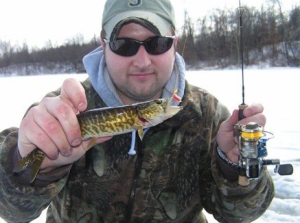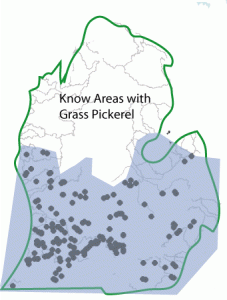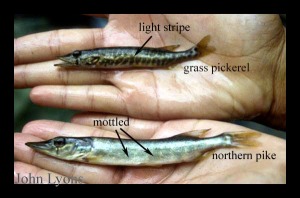 Here in Michigan we’re blessed with so many places to chase Esox like Northern Pike and Muskie,places like Lake Hudson, Fletchers Pond, Detroit River, Lake St. Clair and up and coming Lake Erie. come to mind. What many people don’t know is that we have a third Esox in Michigan.
Here in Michigan we’re blessed with so many places to chase Esox like Northern Pike and Muskie,places like Lake Hudson, Fletchers Pond, Detroit River, Lake St. Clair and up and coming Lake Erie. come to mind. What many people don’t know is that we have a third Esox in Michigan.
Esox americanus vermiculatus the Grass Pickerel is the smallest in the Esox family with the world record only being slightly over 1lb. This toothy little fish is very similar to its larger brethren but one key thing to keep in mind is that they are warm-water fish where as pike and muskie are cool-water fish. So the bodies of water or the areas you will find them in are a bit different. Michigan is the northern edge of its range so there range in Michigan is mostly in the southern part of the state. Now they’re thought to be a common fish here in Michigan but biologist are a little worried because the overall population is down about 25% verses historical numbers within their range.
Common places to find this micro Esox is small to medium lakes with a soft or clay bottom and dense aquatic vegetation . Small to medium streams and rivers with a low gradient such as warm-water head waters or emergent wetland areas are all good places to look for them. You tend to find good numbers in the clearer of these water, like its big brothers they rely a lot on their sight to feed. They feed mostly on small minnow and insects. They tend to stake out and area and sit motionless for hours waiting for prey to come by.
They are regular mistake for juvenile pike by anglers,so many anglers may have caught them and never known it. Grass Pickerel have a dark tear drop under their eye and a light-colored stripe against a darker background down the center of their back. There sides have blotches or vertical lines and unlike the muskie and pike it will lack spots or dark markings on their fins. At two years of age and at least 5 inches they become sexually mature. Spawning can happen in late fall, early winter, or spring all that’s needed is water temperatures between 36° and 54°F. They scatter eggs in small batches over the vegetation. Eggs hatch out in 11 to 15 days and the parents do not stay around to protect them.
Now fishing for them is pretty straight forward. They feed on small minnow, insect, and small frogs.So try small Original Rapalas in size 3 and 5, Small Mepps
inland Spinner in 00 or 0, Johnsons Beatle Spins, Berkley Micro Twister tails in 1.5 inch and small live baits in the softwater season. Through the ice you Panfish lures like tear drops
tipped with spikes or waxworms have worked great for me. I have caught more of them through the ice then at any other time of the year. Target areas with dense standing coontail and cabbage.Also wild rice beds and shallow Lilly pads can be home to these guys. An added bonus to trying to target them is that you might just catch some very large gills and crappies on these same baits.
So tight lines and Screaming drags !

. Flip through the pages and read the surveys results for the lakes. Their listed as Green Pickerel or Grass Pickerel in the charts.



Nice post. I was checking constantly this blog and I’m quite impressed! Extremely helpful information specially the first part. I care for such info much. I was looking for this particular information for a long time. Thank you and good luck.
This web site is stunning. All infromation i need is just right here. Reached this site via “google”